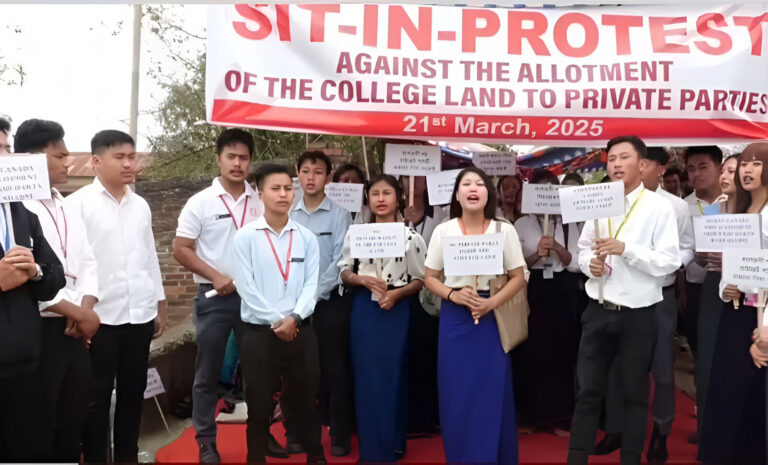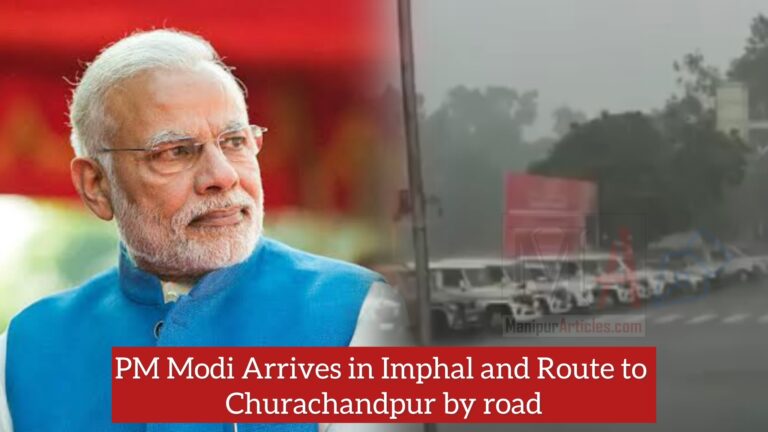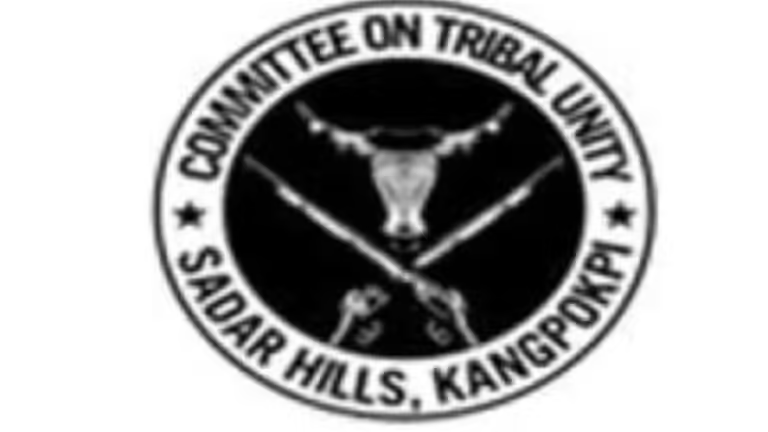Wabagai Apex Body Threatens Road Blockade Over Poor Infrastructure
Summary
The apex body of Wabagai, known as CARD, has issued a three-day ultimatum threatening to block the Wabagai Lamkhai Mayai Lambi road, part of NH-137(A), if the road’s poor condition isn’t addressed. Community members, frustrated by inaction from local authorities despite several pleas, are especially concerned about the dangers posed by the road’s deterioration, which worsens during rainy seasons. This stretch of the road serves as a crucial route, with thousands using it daily, yet remains hazardous and unmaintained.
Long Article
Introduction: When Neglect Breeds Discontent
Imagine navigating a road so bad that it becomes a danger to everyone who uses it. For the people of Wabagai in Manipur, that’s not a distant thought but a daily reality. The Wabagai Lamkhai Mayai Lambi road, a vital stretch that connects communities and supports thousands of commuters, has fallen into severe disrepair. Frustrated and fed up with years of neglect, the apex body of Wabagai—Club Apex Revival and Development (CARD)—has now threatened to impose a road blockade if immediate action isn’t taken.
This isn’t just another case of potholes and uneven surfaces. It’s a story of safety risks, unmet promises, and a community standing up for its rights. In this article, we’ll dive into the issues surrounding the road’s condition, the community’s demands, and why this blockade threat has gained so much attention.
The Importance of Wabagai Lamkhai Mayai Lambi Road
Before we get into the details of the protest, let’s understand why the Wabagai Lamkhai Mayai Lambi road matters so much. This road is part of National Highway 137(A), which connects Wabagai Lamkhai to Kakching. It’s not just a local route; it’s a crucial artery that links various villages and towns, facilitating trade, transport, and daily commutes for thousands of people.
But what happens when a road this vital becomes almost unusable? The community’s daily life grinds to a halt, businesses suffer, and accidents become a grim reality. In fact, as CARD president Huidrom Kishwarjit pointed out during a press meet, several people have already been hospitalized due to accidents on this treacherous road.
A Road Falling Apart: What’s Gone Wrong?
The Wabagai Lamkhai Mayai Lambi road didn’t become hazardous overnight. The deterioration has been gradual, worsened by repeated bouts of rain and lack of maintenance. During the rainy season, the situation turns even more dire. Flooding renders the road almost impassable, potholes transform into craters, and mudslides create an extra layer of danger.
Despite multiple appeals to local authorities—including the area’s MLA and the Public Works Department (PWD)—no substantial action has been taken to fix the road. This has led to rising frustration within the community, and now, they’re ready to take matters into their own hands.
The Threat of Blockade: A Last Resort
CARD, the apex body representing the Wabagai community, recently issued a stern warning: fix the road within three days, or face a complete road blockade. This isn’t an empty threat; the people of Wabagai are serious about enforcing this blockade if the authorities continue to ignore their pleas.
A blockade on such a critical road would have far-reaching consequences. Thousands of commuters would be stranded, businesses would be disrupted, and essential supplies could be delayed. It’s a high-stakes move, but one that the community feels is necessary after years of being ignored.
A History of Inaction: The Road to Frustration
Why has it come to this? The road’s condition has been brought up time and again in meetings with the local MLA and PWD officials, but no concrete steps have been taken to address the issue. It’s as if the voices of Wabagai’s people have fallen on deaf ears, despite the clear danger posed by the crumbling infrastructure.
President Kishwarjit’s statements at the press meet reflect the community’s growing anger. He emphasized that if immediate steps are not taken to repair the Wabagai Lamkhai Mayai Lambi road, the community will have no choice but to move forward with the blockade. To them, this isn’t just about fixing a road—it’s about demanding accountability from the authorities who have failed them.
The Larger Issue: Neglect of Rural Infrastructure
The Wabagai Lamkhai Mayai Lambi road is not the only case of infrastructure neglect in rural India. Across the country, countless communities are dealing with roads that are either underfunded or ignored by local governments. The disconnect between urban development and rural infrastructure is stark, with rural areas often receiving the short end of the stick.
In Wabagai’s case, the situation is exacerbated by the fact that this road is part of a national highway. One would expect a higher level of attention and maintenance, but clearly, that hasn’t been the case. The community’s ultimatum to block the road is their way of saying “enough is enough.”
The Role of CARD: Leading the Charge for Change
CARD, the Club Apex Revival and Development body, has taken the lead in this fight for better infrastructure. The organization has been vocal in its criticism of the authorities and has spearheaded efforts to bring attention to the road’s condition. But CARD isn’t just about protests and threats—they’re pushing for long-term solutions to ensure that the community’s infrastructure needs are met.
Through public meetings, press conferences, and now the threat of a blockade, CARD has kept the pressure on local officials. They’ve made it clear that they won’t back down until real, tangible action is taken.
The Dangers of Poor Road Conditions: More Than an Inconvenience
For the people of Wabagai, this is about more than just inconvenience. The poor condition of the Wabagai Lamkhai Mayai Lambi road poses real dangers to those who use it. Accidents have become alarmingly frequent, with several individuals suffering serious injuries due to the road’s deteriorated state.
During the rainy season, the dangers are even more pronounced. Flooding, slippery surfaces, and landslides make the road a hazard for pedestrians and vehicles alike. The lack of proper drainage further compounds the problem, turning what should be a straightforward commute into a perilous journey.
Looking Ahead: What Will Happen Next?
So, what happens if the authorities fail to act within the three-day ultimatum? If the blockade goes ahead, it will undoubtedly cause significant disruption, not only for the local community but for the wider region as well. The road is a key link for trade and transport, and its closure would have ripple effects on everything from local businesses to access to healthcare.
However, the people of Wabagai are prepared to deal with these consequences if it means finally getting the attention of the authorities. As President Kishwarjit made clear, this is a matter of safety and livelihood for the community.
Conclusion: A Call for Action
The situation in Wabagai highlights a larger issue faced by many rural communities across India. Infrastructure neglect, particularly in critical areas like roads, can have devastating consequences for the people who rely on them. For the people of Wabagai, the Wabagai Lamkhai Mayai Lambi road is more than just a route—it’s a lifeline. And right now, that lifeline is failing them.
The threat of a blockade may be a drastic step, but it’s one that the community feels is necessary to force the authorities into action. The ball is now in the court of the local government and the PWD. Will they step up and fix the road before it’s too late? Or will the people of Wabagai be forced to take matters into their own hands?
FAQs
- Why is the Wabagai community threatening a road blockade?
The community is demanding the repair of the Wabagai Lamkhai Mayai Lambi road, which has become hazardous due to neglect. - Who is leading the protest for road repairs?
CARD (Club Apex Revival and Development), the apex body of Wabagai, is spearheading the effort to get the road fixed. - What are the dangers posed by the current road condition?
The road’s poor condition has led to numerous accidents, especially during the rainy season, making it dangerous for commuters. - Has the government responded to the community’s demands?
Despite repeated appeals, local authorities have yet to take concrete steps to address the issue. - What will happen if the road is not repaired within three days?
The community plans to impose a road blockade, which would disrupt traffic and impact local businesses.



